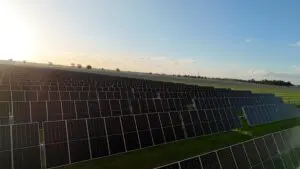A Perth-based energy expert has challenged the conventional view that time of use tariffs and the forced introduction of smart meters are the best way to address the challenges and costs of peak electricity demand, saying we should focus more on better use of solar PV.
Adam McHugh, a lecturer in energy economics and energy policy at Murdoch University, argues instead for a new pricing system that would encourage householders to point their rooftop solar PV panels westward rather than north. Or they could go to the shops, the cinema or the beach at times of peak demand rather than sit at home with the air conditioning.
McHugh says rooftop solar PV could play a major role in reducing network costs, because the price of these systems had fallen so much that they were economically attractive for households to install. However, under the current tariff arrangements, most systems – and it is estimated more than 2,100MW of rooftop solar PV will be in place in Australia by the end of the year – face north because that is where they produce most electricity, and deliver the best returns for households.
But McHugh says that if these systems were facing west, they would correlate with peak demand on the grid, and make a major contribution to lowering network costs. West-facing solar PV panels could reduce system capacity by 75 per cent of their rated output, and one solar PV 1.5kW system could offset a 1kW air conditioner at peak times. This could be significant, given that some forecasts put the extent of solar PV at 12,000MW to 18,000MW between 2020 and 2030.
McHugh’s tariff system is all about reducing the summer peak demand, which occurs in about a dozen interval periods marked by hot, sunny weather. And they occur in mid to late afternoon, when west-facing PV is producing.
“By basing tariffs around peak kW capacity, rather than overall consumption measured in kWh, McHugh says households would face significantly lower bills in winter, spring and autumn, and much higher bills in summer, the season of peak demand. This would encourage them to install solar PV, and point it west, or enter other demand management arrangements that would see them switch off appliances when peak demand was reaching the top 10 or 12 peak intervals. (Tariffs based on individual peak demand would be a PV killer and would not be as effective at reducing network costs.)
Households would be alerted and could take action to slash their bills. In effect, they would be paid to switch off and go to the cinema or the shops, where the air-conditioning would be running regardless of whether there were 2 or 2,000 people in the store. “Why not get in a bit of movie time or retail therapy during the peak?” McHugh says. “Escape the heat and boost the retail sector while cutting your annual electricity bill in half.”
He says this system would encourage owners to orient their solar PV sytems to the west, and others to install interval meters, rather than an imposing an overall cost by rolling them out to all consumers. Everyone (except the monopoly network businesses) would benefit from the tariff change, but those who benefit the most will be customers who buy interval/smart meters that want to participate in system-peak demand reduction activities.
“About 40 per cent of the retail electricity price is caused by network costs,” he says. “Under system-peak pricing, if you had west facing PV and went to the movies during the peak you would not only avoid that 40 per cent, but would receive a credit on your bill for your negative system-peak contribution. North facing PV would also receive a credit, just not as much.”
McHugh says that solar PV facing west and meeting peak demand meant it was effectively acting as a competitor to transmission networks, which is delivering power from distant sources of generation to major demand nodes. This competition may explain some of the perverse tariffs that were now being contemplated, such as the “bi-directional” tariff approved recently by WA’s Economic Regulation Authority which will allow Western Power to charge a higher rate to owners of rooftop panels, even though these mostly north facing panels have reduced peak demand by around 125MW, or the size of a gas-fired peaking generator. Western Power wants to extend such arrangements to battery storage and electric vehicle systems.
“In my view the ERA’s approval of the tariff is a case study in regulatory capture,” he writes in a submission to the Senate inquiry on power pricing. “It seems to me that the bi-directional pricing arrangements approved by the ERA are intended to serve the interests of the regulator and the regulated entity rather than the interests of the public.”
It would not be the only example, as RenewEconomy has pointed out here.
McHugh says a new pricing system would change the way in which consumers think about their contribution to those few half-hourly trading intervals of the year when most of the system costs are incurred. Given that network costs make up such a large proportion of a consumer’s bill, the effect of this change would be to incentivise consumers to reduce their contribution to system-peak demand and therefore lessen the need for network augmentation.
“My hypothesis is that the price of electricity should reflect the cost; then people will orient their PV in whatever direction is best for them,” McHugh says. “North facing PV is good for energy production, west facing PV is good for meeting peak demand.”
“The fundamental flaw in spreading network costs that occur due to system-peak demand across units of energy consumption in other billing periods of the year. Energy-based average pricing (kWh pricing) of this nature does nothing to signal the actual cost of network augmentation to consumers.
“A customer’s individual peak demand will not affect the capacity requirement of the system unless it happens to coincide with the system-peak. So under energy-based network tariffs, or tariffs based on a customer’s individual peak demand, residents and businesses have few incentives to reduce their contribution to system-peak demand and, therefore, network costs.”
He also suggests a new formula for network operators, which instead of rewarding them for inflating demand forecasts, would penalise them for ‘gold plating’ their network. He wants to put the risk of an overly high peak demand forecast on the regulated entity rather than on electricity consumers.








